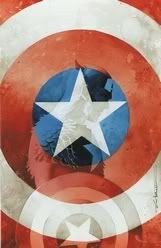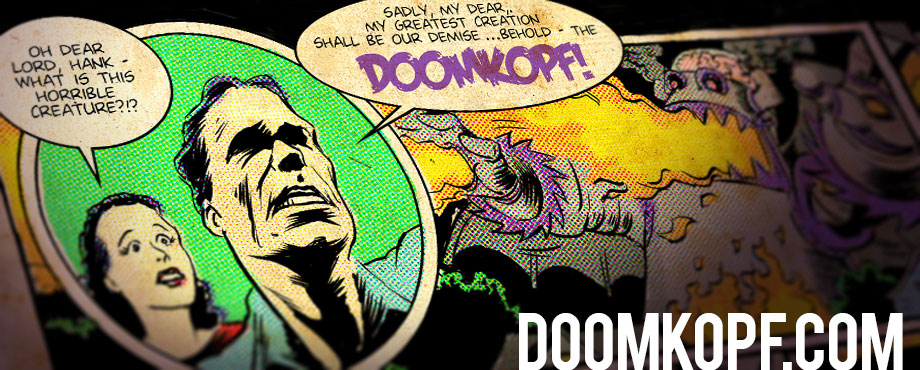Q&A: Mitch Breitweiser and Andy Schmidt
After our exciting initial interview portion with Mitch Breitweiser, who illustrated interiors and painted covers on the new Captain America: The Chosen series, we’re back for more from Mitch, plus a bonus interview with his editor on the series, Andy Schmidt, who has since left Marvel.
 Now, be sure and remember that Captain America: The Chosen is our Book of Doom this week. So come back this weekend for our communal review. Also, we at Doomkopf broke the news of CATCH a few months ago.
Now, be sure and remember that Captain America: The Chosen is our Book of Doom this week. So come back this weekend for our communal review. Also, we at Doomkopf broke the news of CATCH a few months ago.
Now, onto the questions and answers:
JCVD: Do you create art outside of comics at all?
MB: I try to, when I get time, do just regular art. I draw realistic stories all day, all week, all month long. It’s great when I get a
chance to paint an abstract watercolor or something like that. Get that side of the artistic expression out. Hasn’t had time for much in past year, because I’ve been busy. I’d love to do more of that sort of thing. But if comics are paying the bills, I won’t get to do too much.
There are times when a deadline is due when I’ll work 48 hours straight. I’ve been known to do a 48 hour stretch and do three pages. There’ll be days I only work a couple hours. I guess it all averages out to a pretty normal day. Again, working at home makes your schedule flexible. But, on the downside, you have to be very disciplined.
I used to take commissions all the time when I was trying to break in. Now I can’t do that kind of thing anymore. I get done with a deadline and I just crash for a couple of days. I don’t want to touch art. I wish I could work more. I sort of have a strange style of working. If I’m doing a panel, I’ll do some sketches, it’s almost like I’m holding these objects in my hand for awhile, for a couple hours. I’ll just look at rough images. I probably waste too much time.
When I draw, I just attack the panel. I’ll spend a lot more time thinking and looking at things than I do drawing. I spend a lot of
time studying and analyzing and thinking of angles. Getting a clear picture of it in my head. It’s the style that works for me. Maybe I use too much mental energy, because I can’t do it for 16 hours a day.
JCVD: Is it hard as one of the newer artists to get the attention of some of the big-name guys within the company?
MB: It’s like a batting lineup. They get on projects in proportion to how Marvel thinks fans will respond. If you can increase the readership of a falling book, that will get you on a big project. They kind of know what books they want to spend money on. You just kind of have to sit back and hope they put you on it.
I also try to find new readers. Every time I go to a show, a few people come by who haven’t heard of me, and I win a new person over. That’s another way to do it.
JCVD: Ever considered a name change? Something short and catchy?
MB: I actually thought about that once in college. It’s long, but you don’t forget it once you’ve read it. There are some other artists out there with pretty crazy names.
JCVD: What’s your favorite comic book or series?
MB: I really don’t have one specific book. If someone was to ask me, what they should pick up, suggest Captain America. It’s a good starting point. You ask me on another given day, maybe I’d have a different suggestion. I really don’t have one particular book that I think is the end all, be all of comic books. Hopefully one day I’ll be able to work on something that I can point people to.
I’ll be able to say I’m really proud of it and it’s a great story with good art. That’s all you can really hope for. If you’ve done that, then you’ve created a good lasting book. Whether it sold well or not, it’s in someone’s memory.
JCVD: Any dream projects?
MB: Who wouldn’t want to draw the X-Men? That’d be awesome. I was lucky enough last year to draw the Fantastic Four, which was really cool. I’ve recently discovered that I really want to draw Spider-Man. That gritty style doesn’t usually fit him. It’d be cool to bring a feel of a book like, say, Batman to Spider-Man. Present him in a way that’s not usually seen.
JCVD: What about Spidey 2099? He’s still around in Exiles, I think. You could draw that book and get to draw him.
MB: Spider-Man 2099… That would be fun to do. I always loved that costume.
JCVD: Thanks to Mitch and good luck to him. I’m guessing a lot more people will know his name after this series. And, onto my interview with Andy Schmidt, who helped discover Mitch and served as his editor until leaving Marvel this summer.
Andy, after talking to Mitch, it sounds like he really worked his way into his current position by doing lots of traveling and working on his craft and straining to build contacts. I’m not sure when you became aware of him, but I’d like to know what you saw in his persistence and style that impressed you. And I’m also curious if Mitch’s route is typical of a big league comics artist.
Andy Schmidt: I became aware of Mitch when he moved to New York. He was friends with a number of artists here in town and they were happy for him to walk around the office with them. So, when one artist would come in to the office to drop off pages, often Mitch would come in with his own portfolio. I remember Mitch coming in with Sean Chen for a while. Sean was penciling a couple of different books at the time and came into the office about once every two weeks or so. Mitch would swing by my office (and everyone else’s) and calmly and politely drop off photocopies of his samples. They looked really nice but usually only one or two pages at a time. His style looked representational (photorealistic) and had a good sense of the dramatic. I really liked his use of ink washes as well. That technique gave his work a real texture and gray tones.
JCVD: What all books have you worked on with Mitch?
AS: I’ve only worked on two projects with Mitch. The one I can’t talk about yet [this was before CATCH was announced] and the first one he did for Marvel. That was called DRAX THE DESTROYER. It was a science fiction story told over four issues. It was about a interstellar prison ship that crashed in Alaska. The inmates who survived took over a small town and Drax, a fellow inmate
(wrongly convicted, of course) was the only person able to stop them.
Mitch did such a great job on it, that Marvel signed him to an exclusive contract immediately and allowed me to place him on his
next, much larger, project.
JCVD: What do you see as Mitch’s strengths?
AS: His strength is how slick and realistic the art looks when it’s done. It’s beautiful work. His ability to tell a story clearly has really jumped up by leaps and bounds since he was working on DRAX THE DESTROYER with me.
And his characters have become more life-like over the past year. They had a slight tendency to feel a little stiff, but that’s all gone now.
JCVD: Do certain editors typically work with the same artists and help pick projects for them? In general, can you briefly explain how you pick a project for Mitch (or any artist)?
AS: It works differently from company to company. At Marvel, the editors try to be less proprietary than at other companies. I know Mitch the best, so I will probably be involved with helping him land his next project, but it may be with another editorial office. For me, choosing an artist is usually pretty simple: I’ve got a story and in my mind I know what it looks like. I then go and find an artist that approximates what’s in my mind. In the case of DRAX THE DESTROYER, I knew I wanted the environment and the people to feel real, like you could reach out and touch them. I wanted to get as far away from cartoony as I could. The thing that actually sold me on Mitch for that project was his detailed and life-like back grounds and environments.
JCVD: Mitch said he thought it was a conscious effort on Marvel’s behalf to incorporate gritty art and a more realistic feel into its books. Would you say such an effort is going on? If so (or if not) where does Mitch fit into the Marvel movement?
AS: There is a tendency in the realistic direction of art at Marvel. That said, it’s not the right style for every project we do–not by a long shot. We’ve got a line of comics for kids with more cartoony art and we’ve got plenty of stand alone projects with wildly different art.
Marvel’s always keeping a diverse line. At the same time, Marvel has historicaly had a “house style” and right now photo-realistic is in.
JCVD: Thanks again to Mitch Breitweiser and Andy Schmidt. If you haven’t already, go out and pick up Captain America: The Chosen.
